Roblox CodeSignal OA 2025: What Really Happened When I Took the Test

Roblox Codesignal OA Questions
The Roblox OA was on the CodeSignal platform. I had 50 minutes to complete two problems. It wasn’t particularly hard, I solved them pretty smoothly. The first question was about matrices, and the second tested data structure optimization.
I am really grateful for the tool Linkjob.ai, and that's also why I'm sharing my entire OA interview experience here. Having an invisible AI assistant during the interview is indeed very convenient.
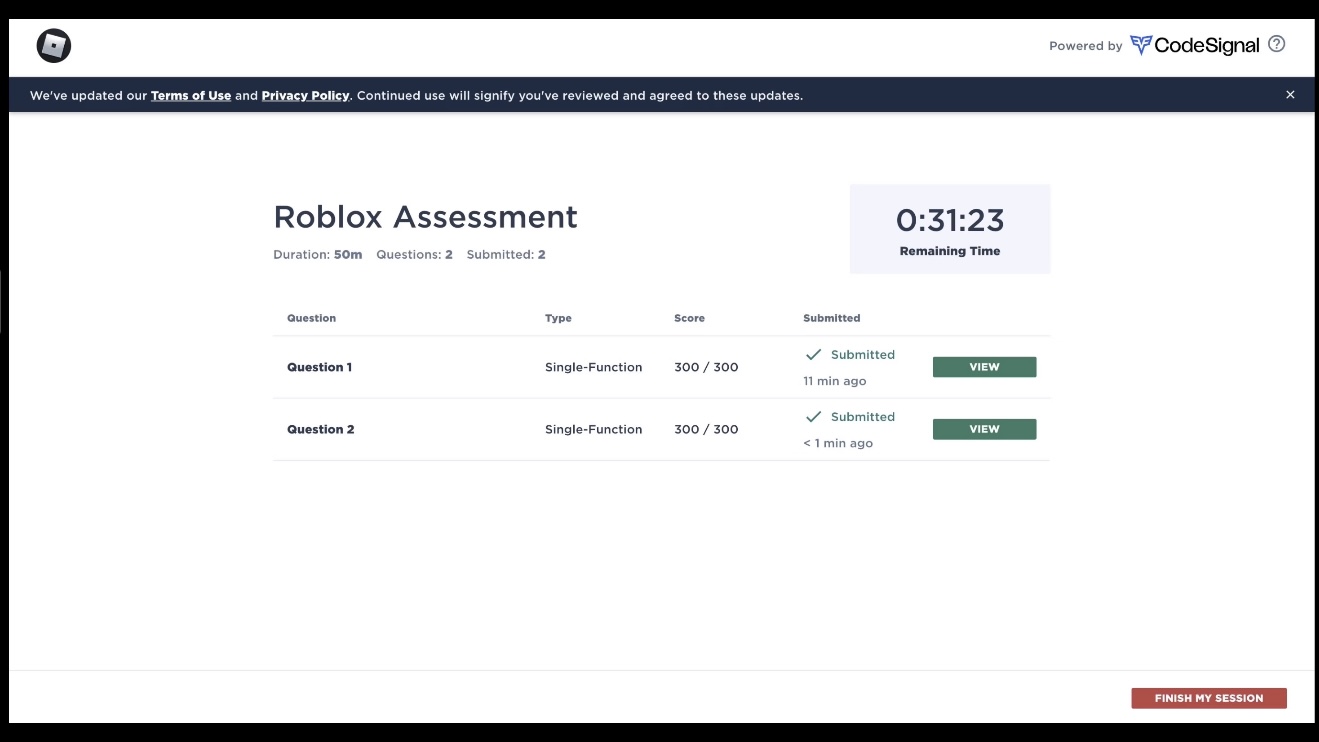
Question 1
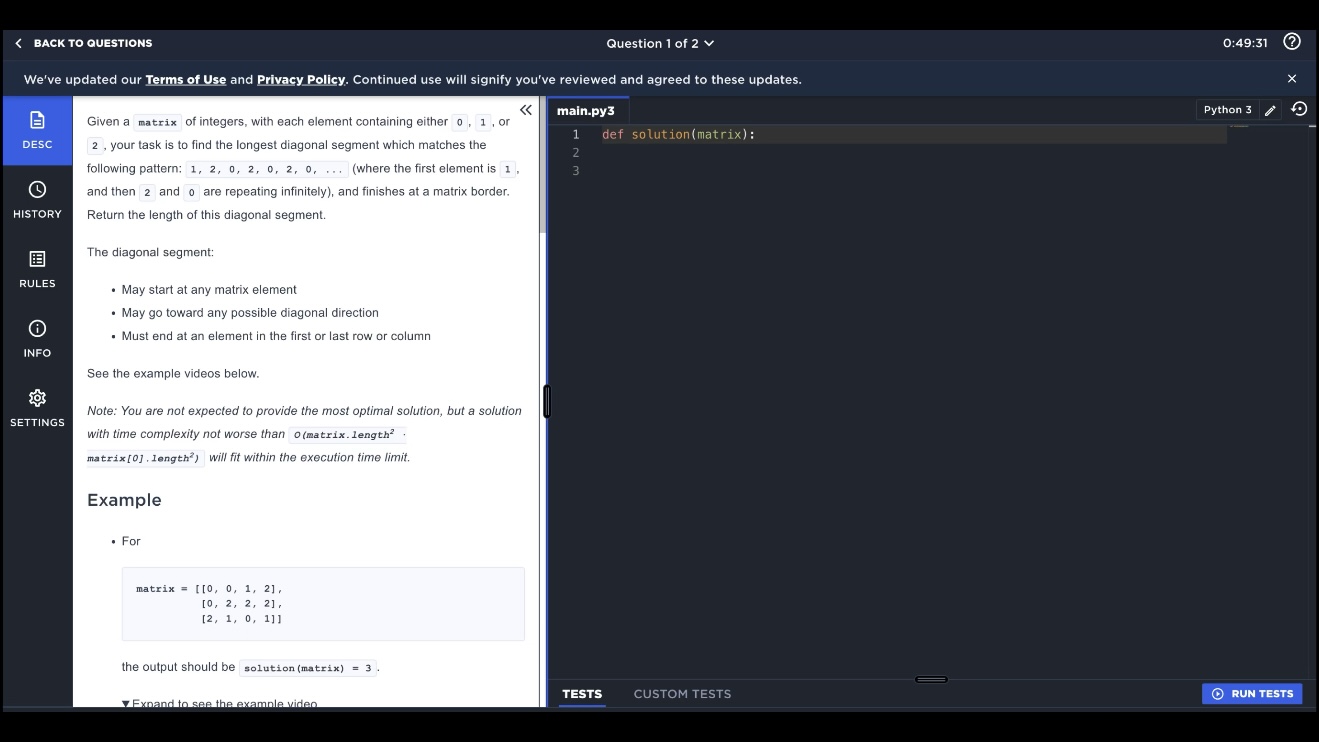
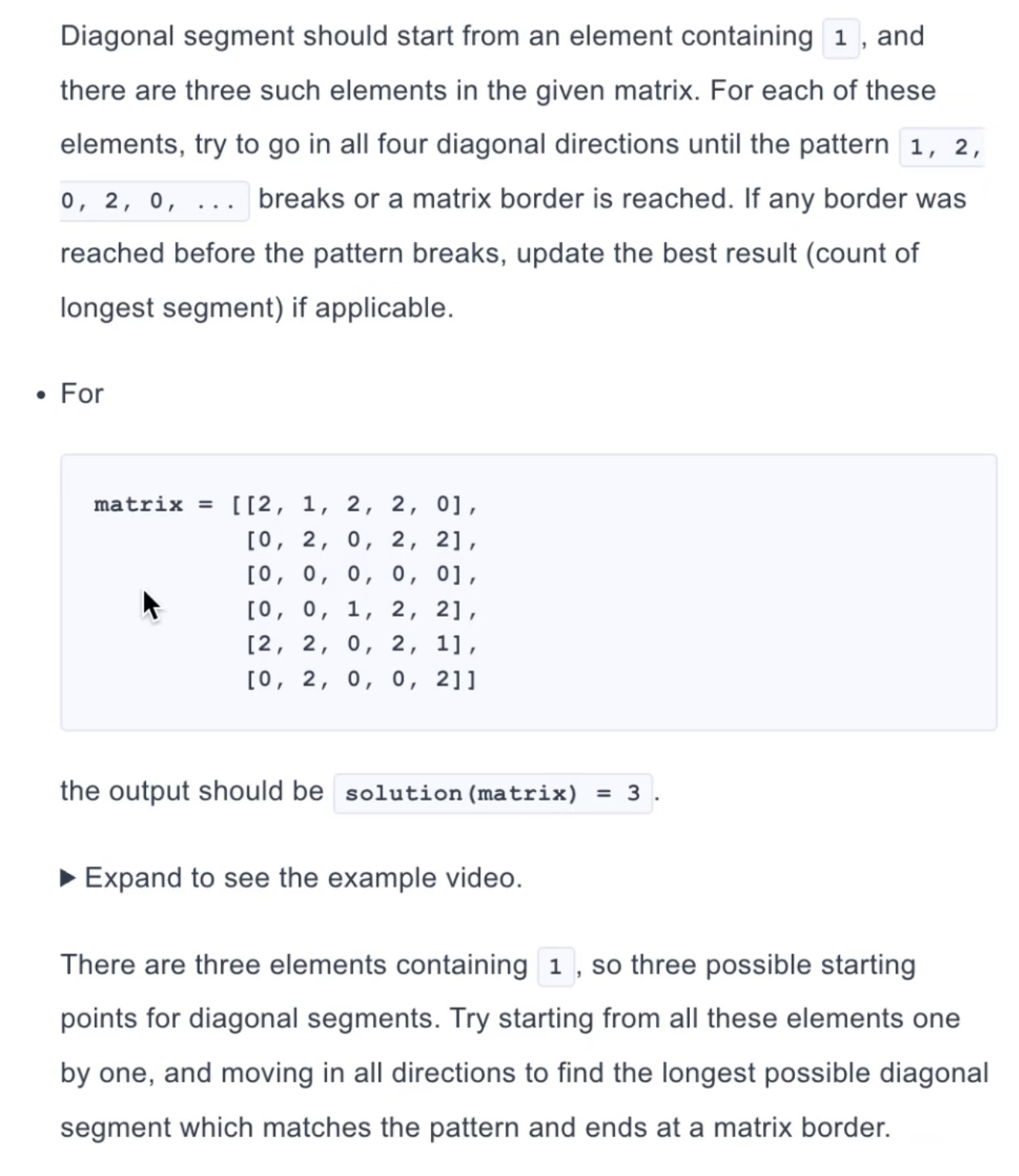
Here’s how I approached this problem back then:
The required pattern was 1, 2, 0, 2, 0, 2, 0…, which meant it had to start from a cell with the value 1. So my first step was to scan the entire matrix and find all positions where the value was 1. These served as potential starting points.
For each starting point, I considered four diagonal directions: top-right, top-left, bottom-right, and bottom-left. Since a diagonal could go in any of these directions, I checked each one individually.
Next, for every start point and direction, I traversed along the diagonal to check if it followed the pattern. The sequence was strict: after 1 came 2, then 0, then 2, and then 0 repeatedly. To handle this, I maintained a pattern index, starting at 0 (the first element in the pattern, i.e., 1). At each step, I moved one cell along the diagonal and checked whether the current value matched the element in the pattern at that index.
I stopped traversal once I hit a boundary or found a mismatch. For each direction, I recorded the maximum matching length, and in the end, among all starting points and directions, I took the largest length as the result. For instance, in the sample test, after locating all cells with value 1 and checking each direction, I found a longest valid diagonal segment of length 3.
In code, it was implemented with nested loops:
The outer loop located all cells with value 1.
The inner loop checked all four diagonal directions from each starting point.
For each direction, I kept traversing while the pattern matched and updated the maximum length.
The time complexity was O(n²) (where n is the matrix size), which met the problem’s requirements.

Question 2
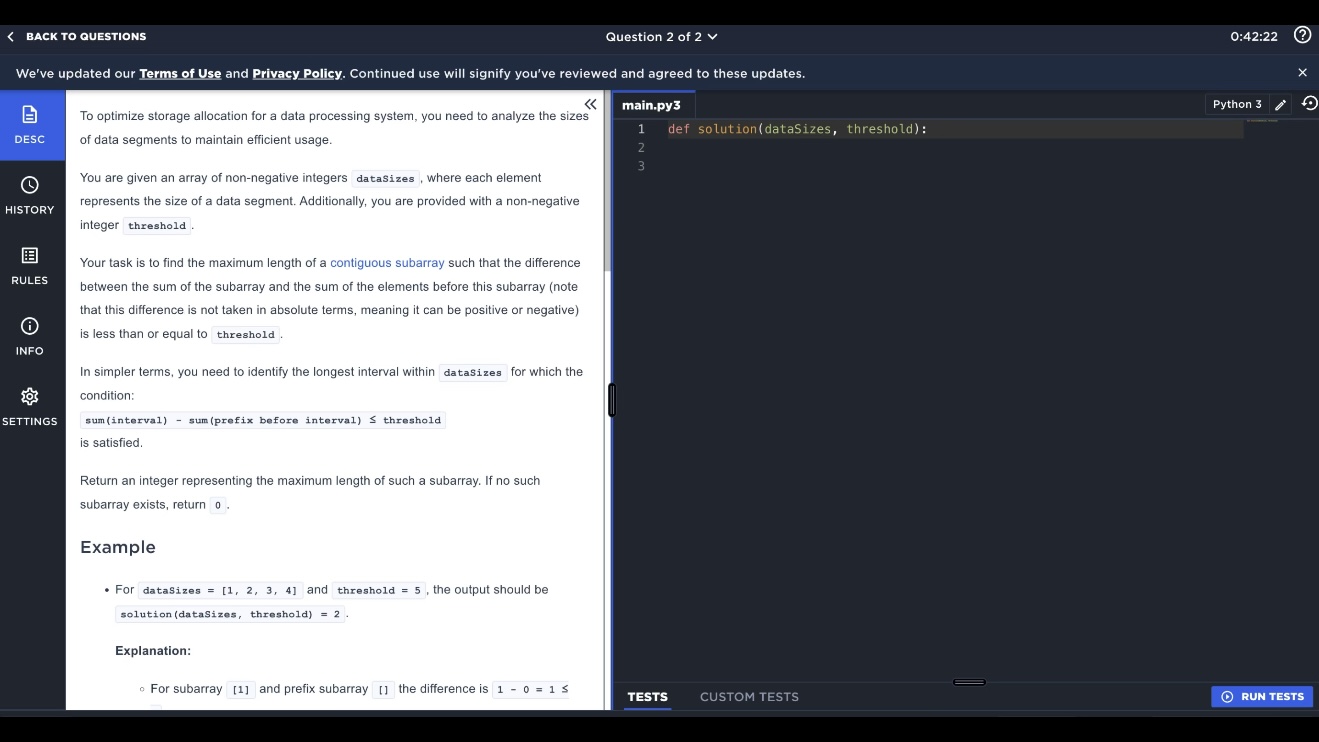
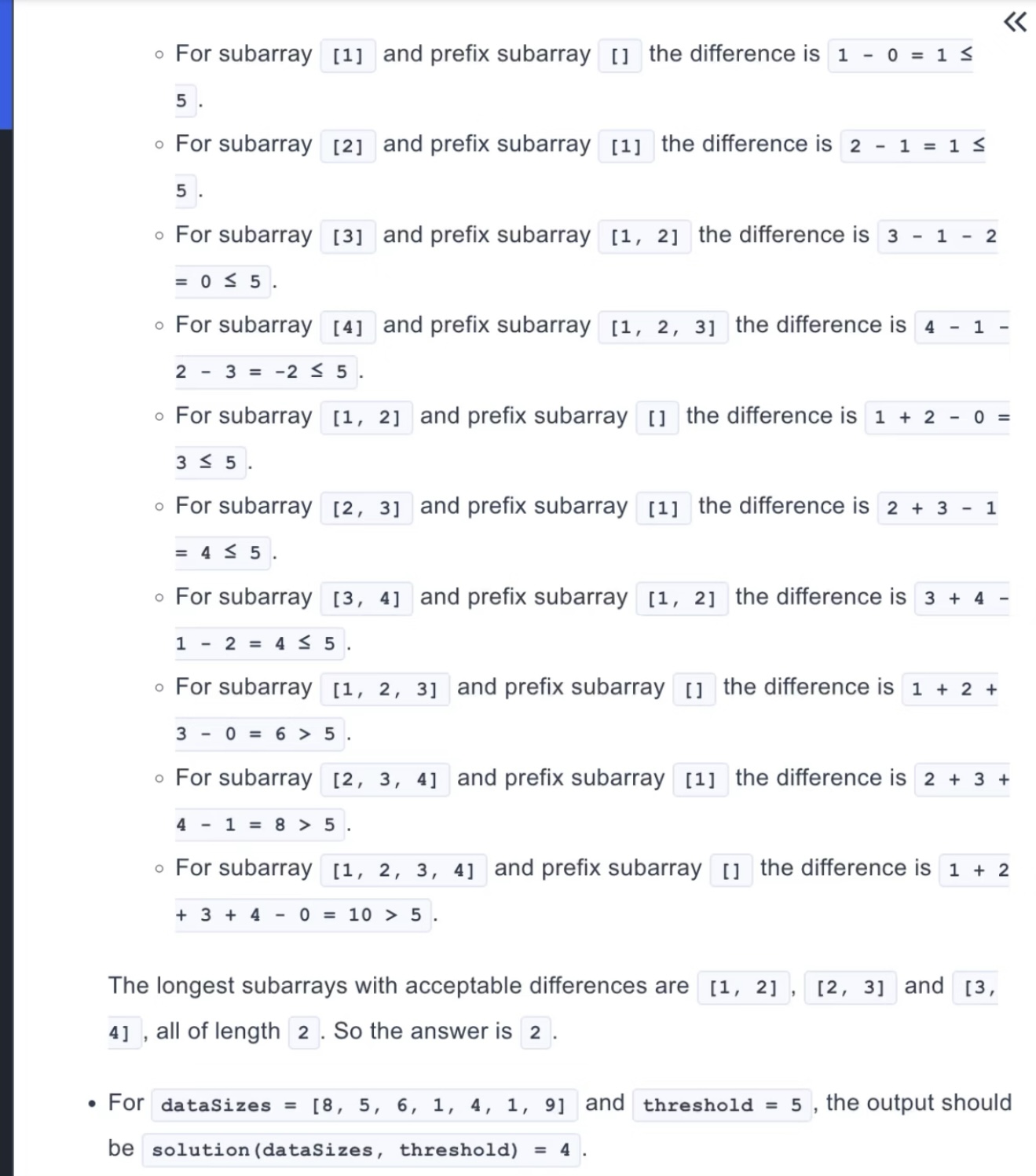
Here’s how I solved this one:
The goal was to find the longest continuous subarray such that
sum(subarray) - sum(prefix before it) ≤ threshold.
I first computed a prefix sum array prefix, where prefix[0] = 0 and prefix[i] represented the sum of the first i elements. For subarray nums[j..k], its sum was prefix[k+1] - prefix[j], and the prefix sum before it was prefix[j]. So the condition became:
(prefix[k+1] - prefix[j]) - prefix[j] ≤ threshold
→ prefix[k+1] - 2 * prefix[j] ≤ threshold.
My goal was to find, for each k, the smallest prefix[j] (where j ≤ k) satisfying this inequality, and then compute the length k + 1 - j, keeping track of the maximum. To efficiently find such j, I maintained a sorted list of prefix sums I had already processed (prev_prefix). For each new prefix[k+1], I needed to find the smallest prefix[j] satisfying
prefix[j] ≥ (prefix[k+1] - threshold) / 2.
To do this efficiently, I used binary search on the sorted list.
My steps were:
I computed the prefix sum array prefix.
I maintained a sorted list prev_prefix for binary searching.
For each current prefix current = prefix[i],
I computed target = (current - threshold) / 2;
I used binary search to find the first prefix[j] ≥ target;
I updated max_length = max(max_length, i - j).
I inserted the current prefix into prev_prefix while keeping it sorted.
This algorithm ran in O(n log n) time. For example, with dataSizes = [1, 2, 3, 4], the prefix sums were [0, 1, 3, 6, 10]. As I iterated, I used binary search to locate valid js satisfying the inequality, and eventually found that the longest valid subarray length was 2.
Roblox Codesignal OA Experience
Format
Roblox’s CodeSignal OA consists of 2 algorithmic coding questions, both in open coding format: the system provides the problem description and input/output examples, and you need to write runnable code in the provided environment to pass all test cases.
The exam interface is divided into three sections:
Problem Area: On the left, it shows the problem requirements, input/output format, and sample explanations. It can be collapsed or expanded at any time for easy reference while coding.
Coding Area: The middle is the main editor, supporting Python, Java, C++, and other major languages. It provides basic syntax hints but does not offer autocomplete for complex functions (e.g., you need to implement binary search yourself, no library calls allowed).
Testing Area: On the right, you can manually input test cases and click “Run” to verify your code. It also shows the number of passed test cases out of the total, helping debug errors.
Time Management
The total OA duration is 50 minutes, starting from the exam start. There is no pause, and when time ends, the system automatically submits the current code; unfinished problems are considered as-is. The two questions share the time, so you can allocate it between them.
Suggested time allocation:
First 5 minutes: Quickly skim both questions, judge difficulty, and prioritize questions with clear logic and less code.
5 minutes per question for debugging: After writing code, first run the sample cases, then manually create boundary test cases to avoid losing points.
Final 5 minutes: Check code formatting and ensure there are no syntax errors.
Tip: Don’t get stuck on one question. If the solution doesn’t come quickly, it’s likely you won’t finish. If stuck for a while, switch to the other question instead of forcing it.
Technical Requirements
CodeSignal’s device and technical requirements are not strict, but overlooking details can directly impact your exam.
Device & Environment Requirements:
Use a computer (preferably a laptop with an external keyboard).
Chrome is recommended; disable ad blockers and extensions to avoid pop-ups.
Ensure a stable internet connection. Mid-exam disconnections will require reconnection, and the reconnection time counts toward total duration.
Programming & Tool Limitations:
Local IDE or external resources are not allowed. The system monitors screen switching, and frequent switching may be flagged.
Master basic algorithms and code optimization. The two questions usually require O(n²) or O(n log n) complexity. For example, matrix traversal (O(n²)) and prefix sum + binary search (O(n log n)); brute-force O(n³) solutions may time out.
Be familiar with input/output handling: in Python, use input() for reading and print() for output. For matrix input, handle multiple lines correctly.
Other Implicit Requirements:
Code must run independently; no external libraries.
Watch for data type overflow: in Java, use long for large numbers; Python handles large integers automatically, but be careful with integer division.
Roblox Codesignal Strategies
Understanding the Problem
Spend the first 3 minutes carefully reading the question. Focus on three key points: clearly define the goal, identify all constraints, and break down the input-output format.
Mark the critical details in the comment section. For example, for the first problem: pattern: 1→2→0→2→0…; directions: 4 diagonals; start point: cells with value 1. This helps keep your logic on track and prevents you from getting distracted by irrelevant details or redundant descriptions.
Validating Your Approach
Once you have an initial plan, validate it using sample test cases. For instance, in the first problem, check whether starting from (0,0) with value 1 and moving diagonally down-right forms the pattern 1→2→0 with a length of 3. If not, adjust your direction or index logic.
Then use edge cases to verify robustness. For example, if the matrix only has one element 1, the output should be 1; if it’s 2, then 0. If your approach is brute-force, test it on large cases to anticipate timeouts and switch to an optimized method early.
Implementing the Code
Once your logic is sound, start coding in the order of core logic → edge cases → input/output.
First, implement the core process. For instance, in the first problem: “find all cells with value 1 → traverse in four diagonal directions → verify the pattern.” You can simplify direction handling using:
directions = [(-1,1), (1,1), (-1,-1), (1,-1)].
Then handle edge cases such as matrix bounds (0 ≤ row < rows, 0 ≤ col < cols) and empty input returns. Finally, write input/output code (e.g. in Python) to read matrix input efficiently. Add comments for clarity and easier debugging:
matrix = [list(map(int, input().split())) for _ in range(n)]Debugging and Optimization
After coding, debug in the sequence samples → edge cases → performance.
Run the provided samples first — if they fail, focus on core logic. Then test edge cases to ensure full coverage.
If the solution passes correctness tests but times out, optimize your time complexity — for example, change a brute-force O(n²) to a prefix-sum + binary search O(n log n) approach in the second problem.
In Python, list comprehensions or built-in functions can often replace redundant loops, improving performance and helping avoid time-limit penalties.
FAQ
Does Roblox’s CodeSignal OA use the General Coding Framework?
No. Roblox’s CodeSignal OA uses its own separate question bank.
How difficult is Roblox’s CodeSignal OA?
The two questions are about as difficult as the last two problems in the standard 70-minute, four-question CodeSignal test.

